Roughly speaking, a set is a collection of objects. The objects are called the members or the elements of the set.
Set theory is the basis for mathematics, and there are a number of axiom systems for set theory; von Neumann-G\"odel-Bernays (NBG) and Zermelo-Fraenkel-Choice (ZFC) are the most well-known. I'll give an informal exposition here, without referring to an axiom system.
You construct or define a set by saying what its elements are.
You can define a set by listing its elements between curly brackets:
![]()
I've been using the "element of" notation for a while.
Definition. ![]() means that x is an element of
the set X.
means that x is an element of
the set X.
![]() means that x is not an element of S.
means that x is not an element of S.
The order of the elements in the list of elements of a set is irrelevant. Thus,
![]()
Definition. Let X and Y be sets. Then ![]() if
and only if X and Y have the same elements.
if
and only if X and Y have the same elements.
It's understood when you list the elements of a set that no
duplicates are allowed: You don't write things like "![]() ".
".
You can also define a set using set constructor notation. Here's an example:
![]()
The set constructor consists of two statements separated by a
"![]() ", contained in curly brackets. The two
statements together give the properties which must be satisfied by an
element of the set. (Thus, the "
", contained in curly brackets. The two
statements together give the properties which must be satisfied by an
element of the set. (Thus, the "![]() " functions like
a logical "and".)
" functions like
a logical "and".)
Some people prefer to follow the rule used above: The statement to
the left of the "![]() " says what big set the constructed
set is a subset of, while the statement to the right of the
"
" says what big set the constructed
set is a subset of, while the statement to the right of the
"![]() " gives the membership criteria for the subset.
" gives the membership criteria for the subset.
However, it is common to write the preceding set as
![]()
This is simpler to write, and avoids the introduction of the unnecssary variable n in the first definition. I'll usually use the second version wherever possible.
This set consists of all integers which are perfect squares. I could write this more explicitly (but less precisely) as
![]()
This is less precise because the "..." assumes that it is clear what the pattern is. However, seeing a number of "sample" elements can make it more obvious what members of the set look like. There's no harm in doing this as long as there's no chance of confusion.
Here's an example using two variables:
![]()
I could also write this as
![]()
This set consists of pairs of real numbers such that the second is the square of the first. (By the way, the last sentence gives a verbal description of the set. It's useful to say things in words when the symbols get confusing.) Here are some elements of the set:
![]()
The set in question is actually the graph of ![]() .
.
In this case, I can't list the elements of the set --- when I discuss cardinality, I'll explain why --- and thus, it's particularly important to have a set constructor definition available.
You can also have sets whose elements are sets. For example:
![]()
This is a set with three elements, two of which are sets with two elements.
Definition. Let X be a set. The cardinality of X is denoted ![]() . For a finite set, it
is the number of elements in X.
. For a finite set, it
is the number of elements in X.
We'll leave aside for the moment what cardinality means for infinite sets. However, I'll note that there are different kinds of "infinite"!
Thus,
![]()
Definition. The set with no elements is called
the empty set, and is denoted ![]() or
or ![]() .
.
Note that ![]() : The empty set is the only set with zero
elements.
: The empty set is the only set with zero
elements.
Remark. You have to be careful in constructing sets in order to avoid set-theoretic paradoxes. For example, here is Russell's paradox. Consider "the set S of all sets which are not members of themselves". Is S an element of S?
If S is an element of S, then by definition S is not a member of itself --- contradicting my assumption that S is an element of S.
If S is not an element of S, then S is an element of S, since S consists of sets which are not members of themselves. This is also a contradiction.
By the Law of the Excluded Middle, either S is an element of S, or it is not --- but both alternatives lead to contradictions.
Paradoxes of this kind are avoided by setting up axioms for set theory which do not allow the construction of sets such as this one.
We've been using some standard notations for certain sets that occur often in mathematics. Here's a recap:
![]() is the set of integers.
is the set of integers.
![]() is the set of rational
numbers.
is the set of rational
numbers.
![]() is the set of real numbers.
is the set of real numbers.
![]() is the set of complex numbers.
is the set of complex numbers.
If you just want the positive integers (also known as the natural numbers, use ![]() or
or ![]() ; if you want the nonnegative integers (sometimes called the whole numbers), use
; if you want the nonnegative integers (sometimes called the whole numbers), use ![]() . Note
that some people include 0 in
. Note
that some people include 0 in ![]() (so by the "natural
numbers" they mean
(so by the "natural
numbers" they mean ![]() ). To avoid confusion, it's
probably better to refer to the "positive integers" or
"nonnegative integers".
). To avoid confusion, it's
probably better to refer to the "positive integers" or
"nonnegative integers".
Definition. Let S and T be sets. T is a subset of S if and only if ![]() implies
implies ![]() .
.
![]() means that T is a subset of S, and
means that T is a subset of S, and ![]() means that T is not a subset of S.
means that T is not a subset of S.
This picture illustrates ![]() :
:
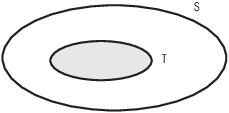
The picture above is called a Venn diagram. Venn diagrams are often useful for picturing sets and relationships among sets. Be careful not to substitute diagrams for proofs, however!
Remarks. (a) Some people use "![]() " to mean that T is a subset of S, but is not
equal to S. A subset of S other than S itself is called a proper subset of S. With this convention, you
write
" to mean that T is a subset of S, but is not
equal to S. A subset of S other than S itself is called a proper subset of S. With this convention, you
write ![]() to mean that T is a subset of S, possibly S itself.
to mean that T is a subset of S, possibly S itself.
I prefer to write ![]() to mean T is any subset of S. If I
want T to be a proper subset of S, I'll write
to mean T is any subset of S. If I
want T to be a proper subset of S, I'll write ![]() .
Reason: More often than not, you want to include the possibility that
.
Reason: More often than not, you want to include the possibility that
![]() , and you should use the simpler notation (
, and you should use the simpler notation (![]() rather than
rather than ![]() ) for the case that occurs more often.
) for the case that occurs more often.
On the other hand, some people prefer ![]() because it is
analogous to writing
because it is
analogous to writing ![]() when x and y are numbers.
when x and y are numbers.
(b) ![]() if and only if
if and only if ![]() and
and ![]() .
.
To see this, note that the relations ![]() and
and ![]() means that every element of S is an element of T, and
every element of T is an element of S --- that is, S and T have the
same elements.
means that every element of S is an element of T, and
every element of T is an element of S --- that is, S and T have the
same elements.
We'll often prove that two sets are equal by showing that each is a subset of the other.
(c) If ![]() (that is, X is a set with n elements) and S is a
subset of X, then each element of X can either be an element of S or
not. Thus, there are 2 choices for each element. It follows that X
has
(that is, X is a set with n elements) and S is a
subset of X, then each element of X can either be an element of S or
not. Thus, there are 2 choices for each element. It follows that X
has ![]() subsets. (Remember that this includes both the empty
set and X itself.)
subsets. (Remember that this includes both the empty
set and X itself.)
Example. List the subsets of:
(a) ![]() .
.
(b) ![]() .
.
(a) The set has 3 elements, so it has ![]() subsets:
subsets:
![]()
Notice that you must write "![]() ", not "a". It is
the set with the single element a, whereas a by itself is
not a set.
", not "a". It is
the set with the single element a, whereas a by itself is
not a set.![]()
(b) The set has 2 elements, namely a and ![]() . Notice that you
don't "unpack"
. Notice that you
don't "unpack" ![]() .
.
Think of a set as a bag. The set ![]() contains a single
element a and another bag (which happens to contain two elements f
and g). The number of things in
contains a single
element a and another bag (which happens to contain two elements f
and g). The number of things in ![]() "at the outer
level" is 2.
"at the outer
level" is 2.
It follows that the set has ![]() subsets:
subsets:
![]()
Notice that "![]() " got "double-bagged: It is a set
containing a set.
" got "double-bagged: It is a set
containing a set.![]()
Example. Let
![]()
Prove that ![]() .
.
To prove that ![]() , I must show that if
, I must show that if ![]() , then
, then ![]() .
You can often prove set inclusion or equality by considering
elements.
.
You can often prove set inclusion or equality by considering
elements.
Let ![]() . By definition of B, I have
. By definition of B, I have ![]() for some
for some ![]() . Now
. Now
![]()
Since m is an integer, so is ![]() . Therefore, n has the form
. Therefore, n has the form ![]() , so by definition
, so by definition ![]() .
.
Hence, ![]() .
.![]()
Lemma. Let S and T be sets.
(a) ![]() .
.
(b) ![]() .
.
Proof. (a) To prove that ![]() , I
have to prove that if
, I
have to prove that if ![]() , then
, then ![]() . But
. But ![]() is false for all x, so the conditional statement must
be true. (In this situation, you often say that the statement is vacuously true --- the condition is satisfied
because there are no cases!)
is false for all x, so the conditional statement must
be true. (In this situation, you often say that the statement is vacuously true --- the condition is satisfied
because there are no cases!)
(b) To prove that ![]() , I must show that if
, I must show that if ![]() , then
, then ![]() .
This is trivially true ---
.
This is trivially true --- ![]() is a tautology --- so
is a tautology --- so ![]() .
.![]()
When one is discussing sets, there is usually a "big set"
which contains all the sets under discussion. This "big
set" is usually called the universe;
usually, it will be clear from the context what it is. For example,
if I'm discussing sets of integers, the universe is the set of
integers ![]() . If I'm discussing sets of real numbers, the
universe is the set of real numbers
. If I'm discussing sets of real numbers, the
universe is the set of real numbers ![]() .
.
Definition. (a) Let S and T be sets in the
universe X. The complement of S is the set of
elements of the universe which are not contained in S; it is denoted
![]() or
or ![]() . Thus,
. Thus,
![]()
(b) The (relative) complement of S in T is the
set of elements of T which are not elements of S; it is denoted ![]() .
Thus,
.
Thus,
![]()
Here's a picture; the shaded area is ![]() .
.
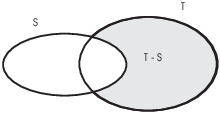
Set complements function likes logical negations; the analogy even extends to DeMorgan's Laws, as I'll show below.
Definition. Let S and T be sets. The union of S and T is the set whose elements are
elements of S or elements of T; it is denoted ![]() . That is,
. That is,
![]()
Picture:
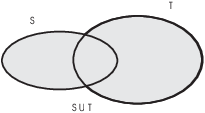
Definition. Let S and T be sets. The intersection of S and T is the set whose elements
are elements of both S and T; it is denoted ![]() . That is,
. That is,
![]()
Picture:
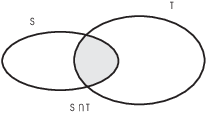
Note that the "or" and "and" in the last two definitions are the logical "or" and "and".
Example. Suppose the universe is the set of positive integers:
![]()
Suppose
![]()
Find the elements of the following sets:
(a) ![]() .
.
(b) ![]() .
.
(c) ![]() .
.
(d) ![]() .
.
(e) ![]() .
.
(a) ![]() . That is, the
set consisting of 5, 7, and all integers greater than or equal to
9.
. That is, the
set consisting of 5, 7, and all integers greater than or equal to
9.![]()
(b) ![]() .
.![]()
(c) ![]() .
.![]()
(d) ![]() .
.![]()
(e) ![]() .
.![]()
You've probably seen interval notation in
other courses (for example, in writing solutions to inequalities).
Suppose a and b are real numbers, where ![]() .
.
![]()
![]()
![]()
![]()
We also have half-infinite intervals:
![]()
![]()
![]()
![]()
In some cases, we'll need to "take apart" a compound
inequality like "![]() " in order to do a proof. A
compound inequality is a conjunction (an "and") of two
inequalities:
" in order to do a proof. A
compound inequality is a conjunction (an "and") of two
inequalities:
![]()
Similar remarks hold when "![]() " is replaced with "
" is replaced with "![]() ".
".
Before I get to the following examples, here's are suggestions for reading these kinds of proofs. The very best thing might be to take the problem statement in the example and see if you can write a proof by yourself --- maybe peeking at the solution when you get stuck.
If you want to simply read these solutions through, check each statement, writing out additional notes or details yourself if something isn't clear. You have to work --- reading a proof is not like reading a comic book! As you read proofs that are longer and more difficult, you should expect to have to work harder --- doing math is like doing exercise. You may not be able to grasp the big picture of a proof the first time through, but at least try to understand the individual steps.
Example. Prove that ![]() .
.
To show two sets are equal, you can show each is contained in the other.
It's possible to write this proof out using lots of logical notation, but I think it makes it somewhat forbidding to read. Hence, I'll write the proof using a combination of symbols and words.
First, I'll prove that ![]() .
.
Let ![]() . By the definition of
intersection, this means that
. By the definition of
intersection, this means that ![]() and
and ![]() . These
statements are equivalent to the compound inequalities
. These
statements are equivalent to the compound inequalities
![]()
As I noted above, each of these compound inequalities can be broken down into two simple inequalities. Doing so, I get
![]()
In particular, I have ![]() and
and ![]() . These simple inequalities are
the same as
. These simple inequalities are
the same as ![]() . But this implies that
. But this implies that ![]() .
.
I've shown that if ![]() , then
, then ![]() . This proves that
. This proves that ![]() .
.
Next, I'll show that ![]() .
.
Let ![]() . This means that
. This means that ![]() , or
, or
![]()
First, ![]() , so together with
, so together with ![]() I get
I get ![]() .
.
Next, ![]() , so together with
, so together with ![]() I get
I get ![]() . Hence,
. Hence, ![]() .
.
(It's interesting to see how the last "Hence" follows from
our rules of logic. By the rule for constructing a
disjunction, "![]() " gives "
" gives "![]() or
or ![]() ". But "
". But "![]() or
or ![]() " is the same
as "
" is the same
as "![]() ". You may not have realized before that
"
". You may not have realized before that
"![]() " contains a logical "or"!)
" contains a logical "or"!)
Continuing with my proof, I have ![]() and
and ![]() , so
, so ![]() . Therefore,
. Therefore,
![]() .
.
Likewise, I have ![]() and
and ![]() , so
, so ![]() .
Therefore,
.
Therefore, ![]() .
.
Since ![]() and
and ![]() , I have
, I have ![]() by definition of intersection. This proves that
by definition of intersection. This proves that ![]() .
.
Finally, since ![]() and
and ![]() , I've proven that
, I've proven that ![]() .
.![]()
Example. Prove that ![]() .
.
I will show that each of the sets ![]() and
and ![]() is contained in the other.
is contained in the other.
Suppose ![]() . By definition of union,
. By definition of union, ![]() or
or ![]() . There are two cases.
. There are two cases.
If ![]() , then
, then ![]() . But
. But ![]() , so
, so ![]() . Hence,
. Hence, ![]() .
.
If ![]() , then
, then ![]() . But
. But ![]() , so
, so ![]() . Hence,
. Hence, ![]() .
.
Thus, ![]() holds in both cases. This shows that
holds in both cases. This shows that ![]() .
.
Now suppose ![]() . Then
. Then ![]() .
.
The idea is that the four numbers which make up the endpoints of the intervals are arranged this way:
![]()
I will take two cases by picking a number between 1 and 6. I choose 3.
Now ![]() , so either
, so either ![]() or
or ![]() . Consider the
two cases.
. Consider the
two cases.
First, suppose ![]() . But
. But ![]() , so
, so ![]() .
Therefore,
.
Therefore, ![]() . Hence,
. Hence, ![]() .
.
(If you think about it, this is constructing a disjunction: ![]() gives
gives ![]() or
or ![]() , which in turn
implies
, which in turn
implies ![]() .)
.)
Second, suppose ![]() . But
. But ![]() , so
, so ![]() . Therefore,
. Therefore,
![]() . Hence,
. Hence, ![]() .
.
Thus, ![]() holds in both cases. This shows
holds in both cases. This shows
![]() .
.
This completes the proof that ![]() .
.![]()
Example. Let
![]()
Prove that ![]() .
.
I'll prove the result by showing that ![]() and that
and that ![]() .
.
To prove that ![]() , I begin
by taking an element of
, I begin
by taking an element of ![]() --- but the only element of
--- but the only element of ![]() is
0. So I have to show that
is
0. So I have to show that ![]() .
.
First, ![]() because
because ![]() . Next,
. Next, ![]() because
because ![]() . Since
. Since ![]() and
and ![]() , it
follows that
, it
follows that ![]() . Hence,
. Hence, ![]() .
.
Now I have to show that ![]() . Let
. Let ![]() . By
definition of intersection, this means that
. By
definition of intersection, this means that ![]() and
and
![]() .
.
Since ![]() , I have
, I have ![]() . Since
. Since ![]() , I
have
, I
have ![]() . This means that
. This means that ![]() , so
, so ![]() . Therefore,
. Therefore,
![]() .
.
This proves that ![]() .
.![]()
We'll see in doing set algebra proofs that Venn diagrams useful in checking that a set relationship is true. However, they become too complicated once there are more than 3 sets.
This is the general Venn diagram for three sets:
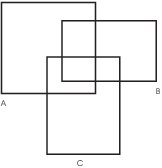
Here are the Venn diagrams for some set constructed using complements, unions, and intersection:
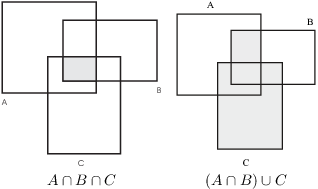
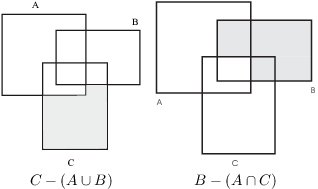
Try to construct a general Venn diagram for 4 or 5 sets!
Copyright 2019 by Bruce Ikenaga